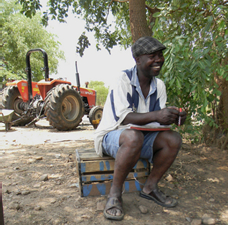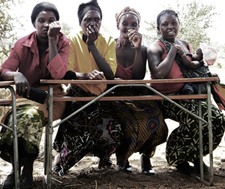James McNulty is a Seconded National Expert working with the European Union Delegation to Zambia. In this Voices & Views, he shares what he learned about the practical application of conservation agriculture from local farmers.
|
I'm a Seconded National Expert (SNE) – as far as I know, the only SNE from the UK to be working in an EU Delegation. It's also my first posting in a developing country, and my first experience working in a European institution. That amounts to a lot of firsts – always a dangerous thing when writing an article because of the temptation to write as if you're the first person to ever have experienced the thing you're writing about. Having said that, I'm also from Scotland – and so in some respects I feel perfectly at home, as both countries are the most saturated places in their respective regions. This article is about conservation agriculture, but also– given that my role involves working on the programming of the 11th European Development Fund – about not getting carried away with simplistic solutions. |
Agriculture in Zambia
It's not news that agriculture is important to most developing countries. But here in Zambia, what's interesting is the depth of consensus about the centrality of agriculture to the reduction of poverty – not just in terms of increasing incomes but also improving nutrition and protecting the environment. The Government, the FAO, the Farmer's Union, and the donor community all agree that a more productive, inclusive and sustainable agriculture sector is at the heart of Zambia's vision to be a prosperous middle-income country.
Which is why it's going to remain a core sector for the EU in Zambia in 2014-2020 – and why conservation agriculture (CA) will be an important component of that future support.
What is CA? It's a cluster of techniques which protect the soil while increasing crop yield. I could describe the Three Pillars, but it'll take me over my word-limit – so at the end of this article you can see a much better video that explains exactly how it works, in language even I can understand.
The point is that the potential here for conservation agriculture is huge – Zambia has access to up to 40% of all the fresh water in Southern Africa, and it currently uses only 15% of the available arable land.
Except, of course, it isn't that simple – where will the equipment and training come from? What happens when donor support stops? Where does the private sector come in? What about government policy.
To explore and learn about some of these issues, I heard first-hand from some Zambian farmers practising Conservation Agriculture in the Chongwe District, and spoke with farmers who had participated in the Farmer Input Support Response Initiative (FISRI), a 16.9m EUR project implemented between 2009 and 2012. What follows below is a summary of what I learnt.
1. Meet Matthias Ndhlovu
He is a fan of FISRI's use of electronic vouchers and the access to tractors allowing him to work on a huge area of land, and to get produce to market. But it hasn't always been easy. Keeping up the payments on the FISRI business loan for his tractor and farm equipment is a struggle. 'But business is good,' he says 'and I should be able to repay the loan in three years'. In fact, he is tempted to try to get more equipment to keep up with the demand.
2. At an open-air meeting in November 2012, smallholders from Lukoshi (right), explained to EU and FAO officials (including me) why they wouldn't return to traditional methods.
- They like being able to plant early
- They enjoy the much higher yields, improving their incomes and enabling them to buy services from Lead Farmers in their area to help them plant and harvest fields.
- They have noticed that using CA means less water run-off, better quality of soil and higher resistance to drought.
Yet despite these benefits, it can often be a challenge for these small farmers to get paid for what they produce in good time – making it very hard to buy inputs for the following season.
3. Despite this, Charles Simulunda, District Agricultural Coordinator for Chongwe (right), was clear about the impact of this increase in yields:
'They can sell far more bags [at time of writing, around 65,000 kwacha (approximately 9 EUR) per 50kg bag, a price set by the Government], because they have increased their production. Their children can go to school; they can buy iron sheets to build their houses.'
Again, the potential is enormous, as EU Ambassador to Zambia Gilles Hervio, stated in his speech of October 2012 to the Zambian National Farmers’ Union Annual Congress:
'This sustainable agricultural method has already been adopted by 20% of Zambian farmers (250,000) which is better than many African countries but far from what we can see in other parts of the world…the US uses 25%, in Argentina 69%, in Brazil 70%, of the total cultivated area… The results in Zambia are more than promising and show us the way forward: fields using this system produce up to three times more and need less inputs than those using conventional agricultural methods'.
As a result, CA is an increasingly important part of the approach the EU takes in Zambia in this sector, and as a driver of progress against Millennium Development Goals 1 (poverty and hunger) and 7 (tackling the effects of climate change). Here, at the Delegation in Lusaka, we are now turning to figuring out exactly what role it will play during the 2014-2020 period.
Policy Challenge
Despite this potential, there are other challenges – particularly on national maize policy. The EU co-ordinates with other donors in its call for agricultural reforms to Zambia's maize policy. This provides an official channel for the selling of maize, however, the government purchasing scheme through the Food Reserve Agency (FRA) is very expensive (currently 2% of GDP).
The big downside of the policy is that the subsequent over-reliance on maize makes it harder for the private sector to get involved, and crowds out investment in other kinds of more nutritious crops more suitable for Zambia's smallholder farmers. Most significantly – it doesn't sufficiently benefit the poor: smallholders make up 80% of Zambia's 1.2 million farmers, yet only 35% sell their crops to the FRA.
Next steps
Agriculture is an important part of the 10th EDF (2008-2013), and as part of our commitment to the sector, we will follow our support to the FISRI Programme with an 11.1m EUR Programme in 2013.
This four-year 'Conservation Agriculture Scaling-Up' (CASU) Programme aims to increase crop productivity and production for the target farmers, at least 40% of which should be women.
Also it will - through the Lead Farmer model – complement the Government of Zambia's policy to scale up CA to make it accessible to about 600,000 farmers in Zambia by 2015.
Key facts
- As well as increasing productivity, CA systems for crops and pastures sequester carbon from the atmosphere into long-lived soil organic matter pools. Potentially one-third of the carbon emitted in current fossil fuel use could be offset by implementing conservation agriculture globally in the next decade. (Source: Food and Agriculture Organisation).
- The FISRI project (2009-2012) purpose was to accelerate progress on MDG 1 by increasing food production through improved access to agricultural inputs and the promotion of CA to help mitigate the effects of soaring food and input prices.
- As a way of overcoming the low extension worker-farmer ratio, the FISRI project piloted the Lead Farmer Approach where lead farmers were trained to provide extension to their fellow farmers and were compensated with inputs and equipment through the use of electronic vouchers. Even formally non-participating farmers are becoming interested and some have started practicing Conservation Agriculture.
- Under FISRI, 19,600 Lead Farmers across Zambia were trained and are in turn are estimated to have trained approximately 300,000 fellow farmers by the end of 2012.
This collaborative piece was drafted with input from James McNulty with support from Raymond Lataste, Jennifer Keegan-Buckley and the capacity4dev.eu Coordination Team.






(3)
Log in with your EU Login account to post or comment on the platform.
Thanks for the comments on this. Yves, are there any specific papers, evaluations or lessons from central America that you think should be more widely circulated for the African context?
Hi James,
I left Central America years ago and my experience was quite local. Experiences of conservation agriculture and at a more extensive scale of agroforestry (agro-sylvo-pastoral systems) were promoted in development programmes ten years ago, building on the know-how of some agricultural research centres (e.g. CATIE in Costa Rica, Univerisity of Zamorano in Honduras, CIMMYT) and giving the oportunity (meaning contacts and funding) to extensionists and farmers organisations to test them. The agricultural policies were not sufficiently strong as to upscale significantly and the general context was and still is of a dismantled extension services. The efforts were often directed toward comercial agriculture but "family agriculture" is now once again on the radar. Maybe there is a possibility that the consensus on climate-smart agriculture could trigger new interest for conservation agriculture. If interested see http://dapa.ciat.cgiar.org/tortillas-on-the-roaster-new-study-to-suppor…
http://www.fao.org/docrep/meeting/024/md046e.pdf (climate change - crops)
and http://www.pcp-agroforestry.org/home (on agroforestry researchs : themes and contacts)
best
Yves
Very interesting!
I also saw good results of conservation agriculture (zero tillage,mulch or soil cover and crop rotation) in Central America where I worked years ago in EU programmes. Focusing on fertility and not only concern for fertilizers triggered a new attention from small farmers to their daily work, it developped curiosity (for a lot of other good practices), more self-esteem . Conservation agriculture is also smart-climate agriculture as it well mentioned so, everything fine but it needs a very good extension service and competent agronomists to ensure the success (at some point it was important to use subsoiler to break a solid underlayer in the soil and allow the roots development)
(I have the feeling that more attention should be given to soils and African soils in particular)